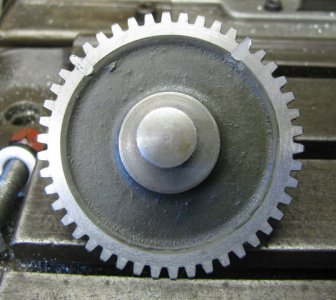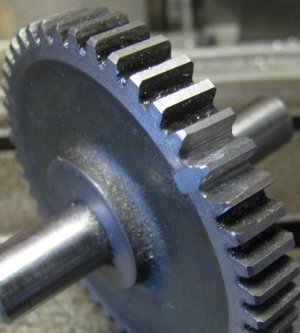My question is in reference to a logan 200 I plan to restore but applicable to any lathe I guess. A couple teeth are missing (nonconsecutive) on one of the gears that is in line with the motor pulley. Looking at it while i spin the chuck, I doesn't appear to be that problematic, seeing that two teeth are engaged at any one time. That being so, I dont want to snap any more off than already are so my question is: What would cause teeth to snap off these gears? Too heavy material? Too much off in one pass? A combination of the two?
-
Welcome back Guest! Did you know you can mentor other members here at H-M? If not, please check out our Relaunch of Hobby Machinist Mentoring Program!
You are using an out of date browser. It may not display this or other websites correctly.
You should upgrade or use an alternative browser.
You should upgrade or use an alternative browser.
What takes teeth off gears?
- Thread starter nayr
- Start date
Good question and await knowledgeable replies but in the mean time... If the gears are brass and the wrong lube was used, it becomes brittle and subject to cracking. Haven't seen that from personal experience but have read about it many times from trustworthy sources.
Ray
Ray
My question is in reference to a logan 200 I plan to restore but applicable to any lathe I guess. A couple teeth are missing (nonconsecutive) on one of the gears that is in line with the motor pulley. Looking at it while i spin the chuck, I doesn't appear to be that problematic, seeing that two teeth are engaged at any one time. That being so, I dont want to snap any more off than already are so my question is: What would cause teeth to snap off these gears? Too heavy material? Too much off in one pass? A combination of the two?
The reasons for broken gear teeth could be just about anything. Something might have fallen in the gears when they were running. As the gears get worn, theres a possibility that they're worn so much that one of the gear teeth didn't engage properly. A high force such as someone jamming the machine could cause it too.
The right question to ask is "should i replace the gear?" The answer is yes, absolutely.
The right question to ask is "should i replace the gear?" The answer is yes, absolutely.
The right question to ask is "should i replace the gear?" The answer is yes, absolutely.
I agree. One of the things that takes teeth off is adjacent missing teeth.
It is often possible to replace teeth:


Those were done on my miller.
Even forming the tooth form by hand will be better than no tooth
Richard
'Son, be a dentist..'
I assume you mean one of the back gears. The Logan 200 lathes were rather notorious for breaking teeth out of the bull gear in some circumstances. I am not sure if that is the gear that you are talking about, however. If you mean one of the change gears, all it takes is to crash the carriage while using power feed. All of the grears on those lathes are cast iron, no brass gears on them.
Thanks for the info. It was not a change gear, it was the large gear to the immediate left of the pulley, which I am guessing is called a back gear. That tooth replacement looks pretty nice and is probably what I will do. Is that just press fit, or is there some kind of JB weld in there as well?
JB weld is crap depending on what it is made of I usually weld them up and start in with a dremal and a parting wheel followed up by a file. If it is cast iron stoody makes a welding rod called castweld GP it works really good or if it is cast iron, steel you can braze them in or if it is just steel fill it in with and arc welder or wire feed or TIG. If it is aluminum TIG is the best way to go I have also welded pot metal gears with alladin 3 in 1 and a TIG.. Ray

